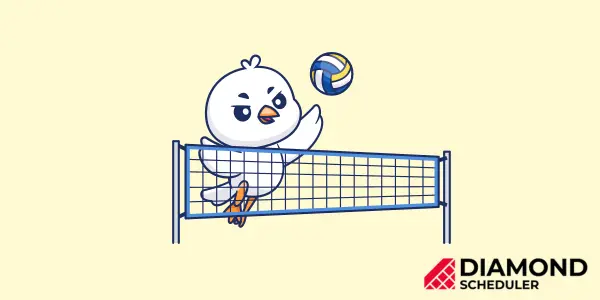
The League Owners’ Guide To Volleyball Court Dimensions
One of the biggest sports in the world, volleyball has seen rapid growth over the past decade with its increasing popularity in the collegiate and professional spaces. As a recreational sport, it has long been among the favorites as a pastime across the world in countries like Brazil, where you're sure to find games along the beautiful beaches of Sau Paulo or in China, where the women's national indoor team has won six Olympic medals.
There's no doubt that the sport will continue to grow, and with it many opportunities to join in on the fun and capitalize on the nine figure USD market size of the industry. But having a keen eye for the sport as a fan and a business opportunity isn't quite enough. As a new or aspiring volleyball league owner, one must also understand the ins and outs of how the game is played, safety considerations, game scheduling, and, most importantly, court dimensions.
In this article, we'll provide a complete guide for league owners on volleyball court dimensions and the other important aspects of the game, such as the best volleyball scheduling software and some helpful resources for league owners of all kinds!
Standard volleyball court dimensions

Volleyball courts come in varying sizes depending on the venue and level at which the game is being played. Understanding these different measurements can be vital when setting up a league or operating indoor and outdoor tournaments.
a. Length and width measurements
The following are the length and width measurements mandated by various volleyball associations and governing bodies.
-
Indoor Volleyball: NFHS (National Federation of State High School Associations)
Length: 60 feet (18.29 meters)
Width: 30 feet (9.14 meters)
-
Indoor Volleyball: NCA (National Collegiate Athletic Association) A, FIVB (Fédération Internationale de Volleyball), and USAVB (USA Volleyball)
Length: 59 feet (18 meters)
Width: 59 feet (18 meters)
-
Outdoor/Beach Volleyball: NCAA, FIVB, USAVB
Length: 52.6 feet (16 meters)
Width: 26.25 feet (8 meters)
-
Outdoor/Beach Volleyball: Recreational
Length: 52.5 feet (16 meters)
Width: 26.25 feet (8 meters)
b. Boundary lines
Boundary lines are the lines that define the playing area in volleyball. The particular dimensions of the court and the lines may vary based on the level of play and the restrictions of the governing body.
The volleyball court is rectangular in design, with a midline dividing it into two equal halves. The court is bordered by boundary lines that regulate whether or not a ball is in play. Here are the important volleyball boundary lines:
1. Sidelines
On each side of the court, these are the lines that run parallel to its length. They serve as the playing area's left and right borders.
2. Baselines
These are the lines that, at each end of the court, run parallel to its width. They serve as the playing area's back markers.
3. Attack lines
These lines are positioned 3 meters (or 10 feet) on either side of the centerline, parallel to it. The attack lines are positioned at a varied distance from the centerline in several sports variants, such as beach volleyball.
4. Centerline
Travels perpendicular to the sidelines and, through the center of the court, splits the court into two equal halves. It is used to divide the teams' front and back rows and to assign places during serves.
5. Service lines
These lines run parallel to the centerline at the back of the court. They indicate the area the server must occupy while serving.
c. The attack line
The attack line plays one of the most crucial roles in volleyball and marks the divide between the defensive and offensive areas on each side of the volleyball. Front-row and back-row players are divided by this line, with players in the front row (usually three) able to attack the ball above the net's height. Back-row players play more of a defensive role, usually setting up players in the front zone and passing.
Different types of volleyball courts
Indoor courts
Outside of high school volleyball, the FIVB is the international governing body that regulates volleyball on a global level. The organization sets forth the following official guidelines:
The playing field must be surrounded by a free zone that is at least 3 meters wide on all sides.
A volleyball court measures 59 feet by 29 feet 6 inches in feet.
The volleyball court's playing area must be rectangular and symmetrical.
The free zone is included within the playing area
Flooring material
Hardwood or synthetic are the only permissible materials to be used within FIVB-regulated tournaments, and the playing field must be light in color and flat. All line markings must be white and contrast with the floor.
Lighting requirements
The recommended lighting set forth by the FIVB is at least 300 lux (illuminance), with the preferred range being between 500-700 lux.
Outdoor/beach courts
Beach volleyball has similar requirements but is typically played on smaller court dimensions. The following are some of the aspects of a beach volleyball court:
A beach volleyball court's dimensions are 52.5 feet by 26.2 feet
The rectangular court must have a free zone surrounding it that is at least three meters wide
Sand maintenance
A beach volleyball court can be maintained by keeping the surface flat and free of debris like pebbles, shells, or sharp objects that could pose injury to players. Rakes and sand-cleaning machines can be helpful in maintaining a level and clean court.
Environmental factors
Playing outdoors leaves players and fans exposed to the elements, and weather conditions like wind, rain, and especially heat can affect the game. Overexposure to heat should be monitored carefully, and players should be equipped with hydration, protective wear, and sunscreen.

Net height regulations
Net heights differ between men's and women's volleyball. Here are the following regulations for each (the following measurements are to be taken at the center of the net):
Men's volleyball net height
Standard (under 55 years): 7 feet, 11 5/8 inches
Ages 55-69: 7 feet, 9 5/8 inches
Ages 70+: 7 feet, 6 inches
Women's volleyball net height
Standard: 7 feet, 4 1/8 inches
Ages 45+: 7 feet, 2 1/8 inches
Youth volleyball net height
Boys and Girls - Ages 11 & 12: 7 feet
Boys - Ages 10 and under: 7 feet
Girls - Ages 10 and under: 6 feet, 6 inches
Scheduling games and court availability
Now that we've gotten through all the nitty-gritty details about volleyball court dimensions, let's talk about the facility/venue scheduling, an important part of being a league owner. Scheduling games with potential venues, managing team availability, and overseeing tournaments are a lot to juggle. In the second half of the article, we will review the various elements required when creating a balanced volleyball league schedule and resources that can help.
Balancing team availability
When creating a schedule and planning a tournament, it's important to have a main point of contact available for all coaches and other staff to be able to reach you; this way if scheduling conflicts arise, changes can be made quickly and accordingly if possible. Open lines of communication between teams and league owners will allow schedulers to understand the various constraints—travel or venues surrounding the team and scheduling solutions.
Facility availability and reservations
Finding an available venue can be a timely process. Usually, paperwork needs to be completed, especially if it is the first time you are using the facility.
Another thing to remember is that not all venues will have all the equipment you'll need for the tournament. It's a good idea to come prepared with your own equipment, such as post padding and a scorer's table, so the tournament is ready on game day.
Organizing tournaments and managing multiple games
Organizing a tournament and scheduling the games can be one of the most difficult aspects for a league owner. A volleyball tournament will typically start in a round-robin format so that teams can be ranked based on how many games they have won.
A volleyball competition of twelve teams, for instance, would probably have three pools, each with four teams. Additionally, this ensures that each club will play a minimum of three games before entering the championship bracket.
For a closer look at a round-robin tournament, check out “What Is a Round Robin Tournament? Your Go-To Game Guide.”
Thankfully, to make things easier, there is software like Diamond Scheduler, which streamlines the scheduling process. As the scheduling software leader, the platform uses powerful constraints, SportsEngine integration, and ease of use application and round-robin formats to get the job done.

Elimination round/brackets
Once teams have completed the round-robin portion of the tournament, it is time for the bracket to the final game. Typically brackets will have higher-ranked teams paired with lower-ranked ones. For example, a 1st seed and an 8th seed, a 2nd seed and 7th seed, and so on.
Distance from the crowd and safety considerations
Because volleyball players are able to play within the free zone outside of the playing court, a 2-meter buffer zone or barrier is usually in place to minimize risks of injury to contestants and spectators.
The FIVB has detailed safety guidelines for volleyball tournaments that include measures on spectators, officials, and players, which can be found here.
Frequently asked questions
What are the different volleyball court dimensions?
Volleyball courts come in varying sizes depending on the venue and level at which the game is being played.
Indoor volleyball for the NFHS measures 60 feet (18.29 meters) by 30 feet (9.14 meters).
Indoor volleyball at the NCAA, FIVB, and USAVB levels measures 59 feet (18 meters) by 59 feet (18 meters).
Outdoor/beach volleyball at the NCAA, FIVB, and USAVB levels measures 52.6 feet (16 meters) by 26.25 feet (8 meters).
Recreational outdoor/beach volleyball recreational length: 52.5 feet (16 meters) by 26.25 feet (8 meters).
What are the dimensions of an AAU volleyball court?
AAU courts are 18 meters by 9 meters with a 2-meter free zone on the sides and a 7-meter free zone on the ends.
What are the dimensions of a 2-on-2 volleyball court?
The dimensions of a 2-on-2 volleyball court are 26’3" x 52'6".
Are volleyball court dimensions different indoors and outdoors?
Yes, outdoor/beach courts are smaller in size. This is partly due to a lack of mobility for players in sand compared to a hardwood or synthetic surface.
Recap
To summarize, knowing the dimensions of a volleyball field is critical for both players and organizers to ensure fair and competitive gameplay. The International Volleyball Federation's (FIVB) defined dimensions offer a consistent framework for the sport worldwide.
As a league owner, scheduling tournaments and doing so with no conflict is the other main point of focus.
Professional and youth volleyball leagues alike can include many teams and constraints to be worked into the schedule and use Diamond Scheduler, which has the ability to create a printable tournament bracket and schedule complex constraints within a round-robin format in minutes.
Try Diamond Scheduler for free, easily import your league structure and while you're at it, take advantage of all the great resources on the Diamond Scheduler blog, tailored exclusively for league owners!
Jeff Tipper is an avid sports fan who has a strong passion for basketball. A graduate of the University of New Mexico with a Bachelor's Degree in Operations Management, Jeff has experience in operations and claim processing and spends his free time writing articles and blogs focused on sports and various business topics.



